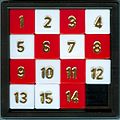Permutation
A permutation is a single way of arranging a group of objects. It is useful in mathematics.
A permutation can be changed into another permutation by simply switching two or more of the objects. For example, the way four people can sit in a car is a permutation. If some of them chose different seats, then it would be a different permutation.
Permutations without repetitions
The factorial has special application in defining the number of permutations in a set which does not include repetitions. The number n!, read "n factorial",[1] is precisely the number of ways we can rearrange n things into a new order. For example, if we have three fruit: an orange, apple and pear, we can eat them in the order mentioned, or we can change them (for example, an apple, a pear then an orange). The exact number of permutations is then [math]\displaystyle{ 3! = 1 \cdot 2 \cdot 3 = 6 }[/math]. The number gets extremely large as the number of items (n) goes up.
In a similar manner, the number of arrangements of r items from n objects is considered a partial permutation. It is written as [math]\displaystyle{ nPr }[/math] (which reads "n permute r"), and is equal to the number [math]\displaystyle{ n (n-1) \cdots (n - r + 1) }[/math] (also written as [math]\displaystyle{ n! / (n-r)! }[/math]).[2][3][4]
Permutation Media
In the popular puzzle Rubik's cube invented in 1974 by Ernő Rubik, each turn of the puzzle faces creates a permutation of the surface colors.
In the 15 puzzle the goal is to get the squares in ascending order. Initial positions which have an odd number of inversions are impossible to solve.
Related pages
References
- ↑ "Compendium of Mathematical Symbols". Math Vault. 2020-03-01. Retrieved 2020-09-10.
- ↑ "List of Probability and Statistics Symbols". Math Vault. 2020-04-26. Retrieved 2020-09-10.
- ↑ "Combinations and Permutations". www.mathsisfun.com. Retrieved 2020-09-10.
- ↑ Weisstein, Eric W. "Permutation". mathworld.wolfram.com. Retrieved 2020-09-10.




